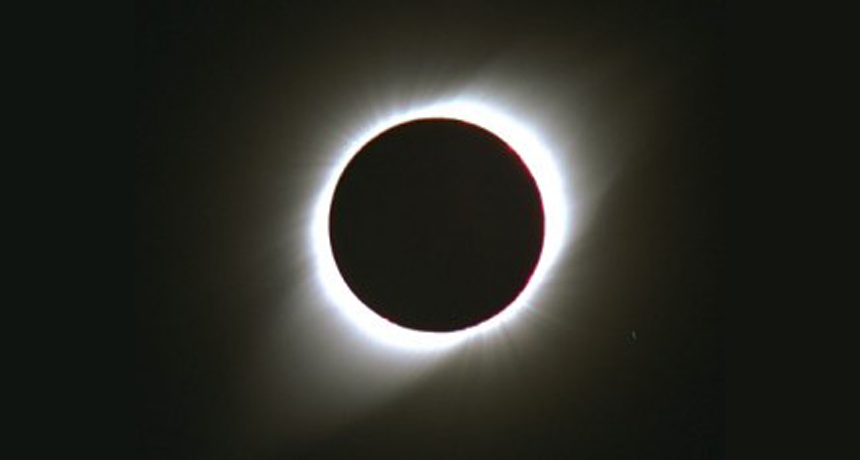How the outer sun gets so hot
Magnetic waves boost the corona to extreme temperatures

During a total solar eclipse, the sun’s surface is completely blocked by the moon, but the outer layer of the sun, called the corona, is visible as a bright halo.
Fred Espenak/NASA's Goddard Space Flight Center
The solar corona is a superhot envelope that surrounds the sun, just as Earth’s atmosphere surrounds our planet. The only way to see the corona from Earth is during a solar eclipse — and even then, observers have to wear special “eclipse” glasses or risk permanent eye damage. The corona is also a source of mystery: Scientists have known for decades that this layer can be millions of degrees hotter than more inner layers of the sun.
If that doesn’t seem unusual, consider this: If the same thing were true of a campfire, you’d be more likely to burn your finger if you held it far away than up close. And if you wanted to roast a marshmallow, you’d be able to do so far from the flames.
Scientists know a lot about the sun. It’s the nearest star, it shines all the time and it provides the energy needed for life on Earth. But what’s heating the corona? Scientists have been scratching their heads and brainstorming ideas about why the outer layer is so blazing hot, especially when there are cooler layers below. Some have long wondered if magnetic waves help to heat the corona.
In a new study of solar observations, scientists indeed discovered waves in the corona that could add oomph to the heating process. The waves might also play a role in the solar wind, a stream of energetic particles that flows away from the sun.
All waves carry energy from one place to another, but waves that heat up the corona aren’t like ocean waves that form in the water and break on the shore. The waves in the sun’s outer atmosphere are more like the waves you see when you pluck a guitar string — although instead of wiggling along a string, the waves wiggle along the lines of a magnetic field.
If you’ve ever used a magnet instead of your fingers to push or pull another magnet, you’ve seen a magnetic field at work. It’s the space where one magnet can move another. A magnet always has two poles, usually called north and south. The lines of the magnetic field look like loops that connect these two poles. In the corona, magnetic field lines are constantly changing. In the new study, the researchers found and measured waves traveling along these magnetic field lines all over the corona.
“What surprises me is that they are seen absolutely everywhere and with energy levels that are able to do things to the corona,” space scientist Peter Cargill told Science News. Cargill, of Imperial College London and the University of St. Andrews in Scotland, was not involved in the new study.
On a small scale, the waves aren’t very powerful. But working together, they’re strong enough to launch the solar wind away from the corona. Plus, the researchers say that the corona’s waves vibrate at about the same rate as waves detected much closer to the sun’s center, in a layer called the chromosphere. Finding such similar waves so far apart suggests they may be the same waves.
Earlier this year, the same scientists discovered powerful gas jets that blast from deeper within the sun into the corona. These jets may shuttle the magnetic waves into the corona. If the jets are like the rockets that lifted space shuttles high above Earth, the magnetic waves are “like the main engine for the final push,” researcher Scott McIntosh told Science News. McIntosh, who studies the science of stars at the National Center for Atmospheric Research in Boulder, Colo., worked on both of the sun studies.
Armed with new information, scientists may finally solve the mystery of the superheated corona. Though they still don’t know the precise details of how the process works, they hope it won’t take another half-century to find out.
POWER WORDS
corona The envelope of the sun (and other stars). The sun’s corona is normally visible only during a total solar eclipse, when it is seen as an irregularly shaped, pearly glow surrounding the darkened disk of the moon.
solar eclipse An event in which the moon’s shadow covers the sun’s surface and reveals its outer layer, the corona.
magnetic field A region around a magnetic material where the force of magnetism acts.
chromosphere A red, gaseous layer above the most visible part of the sun or other star. The inner part of the sun’s atmosphere.
atmosphere The envelope of gases surrounding Earth or another planet.







